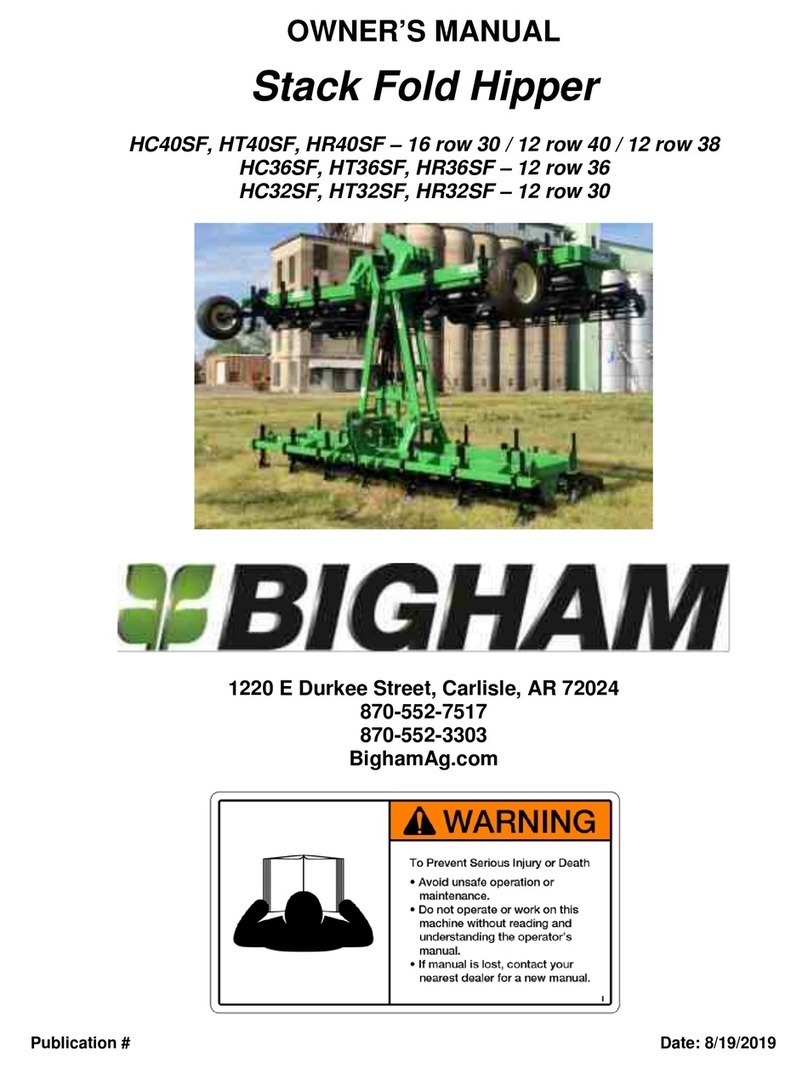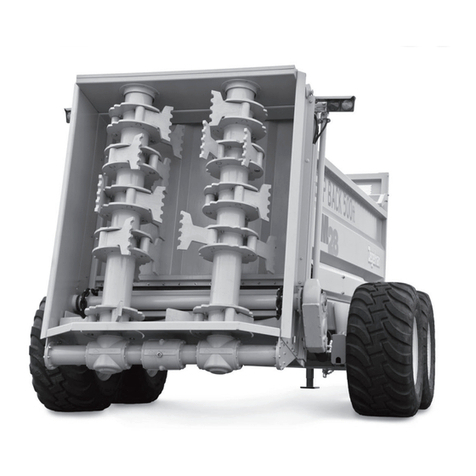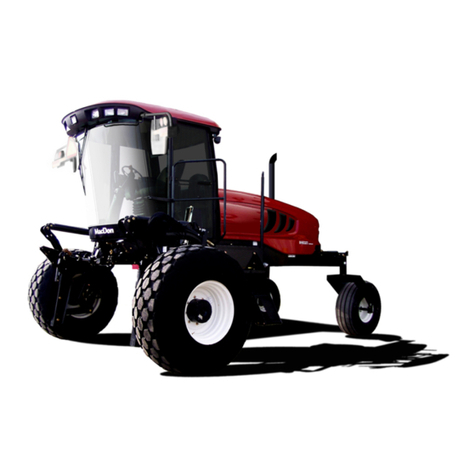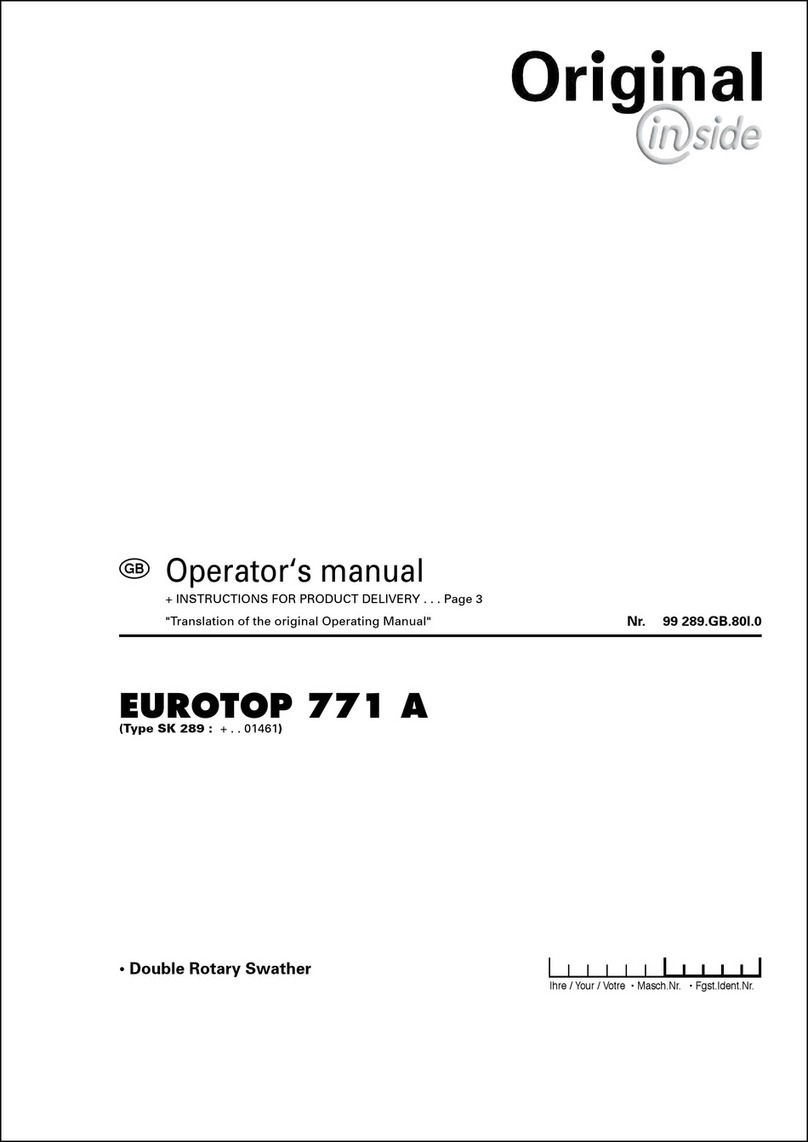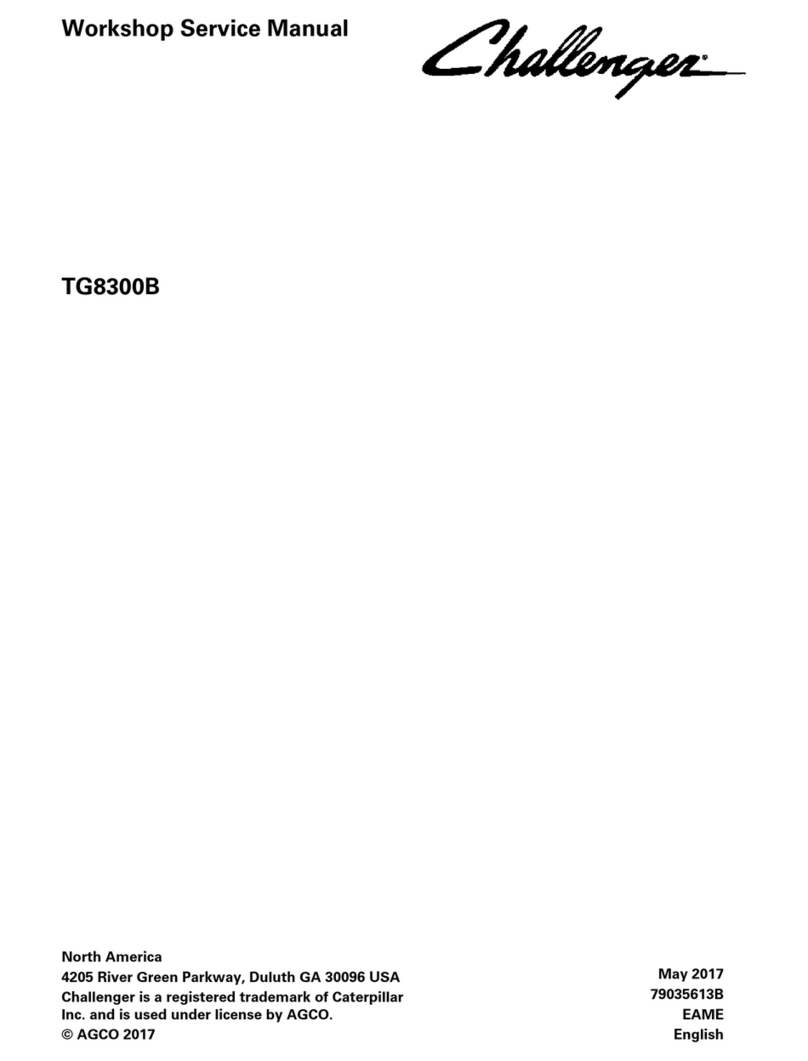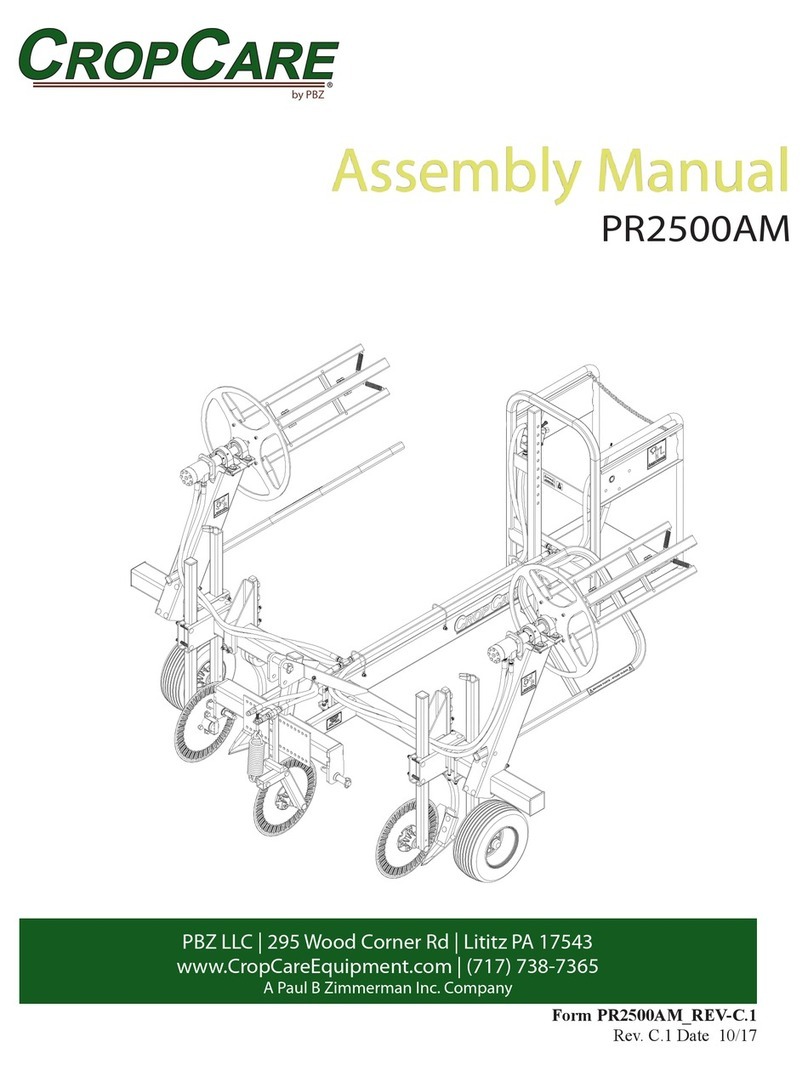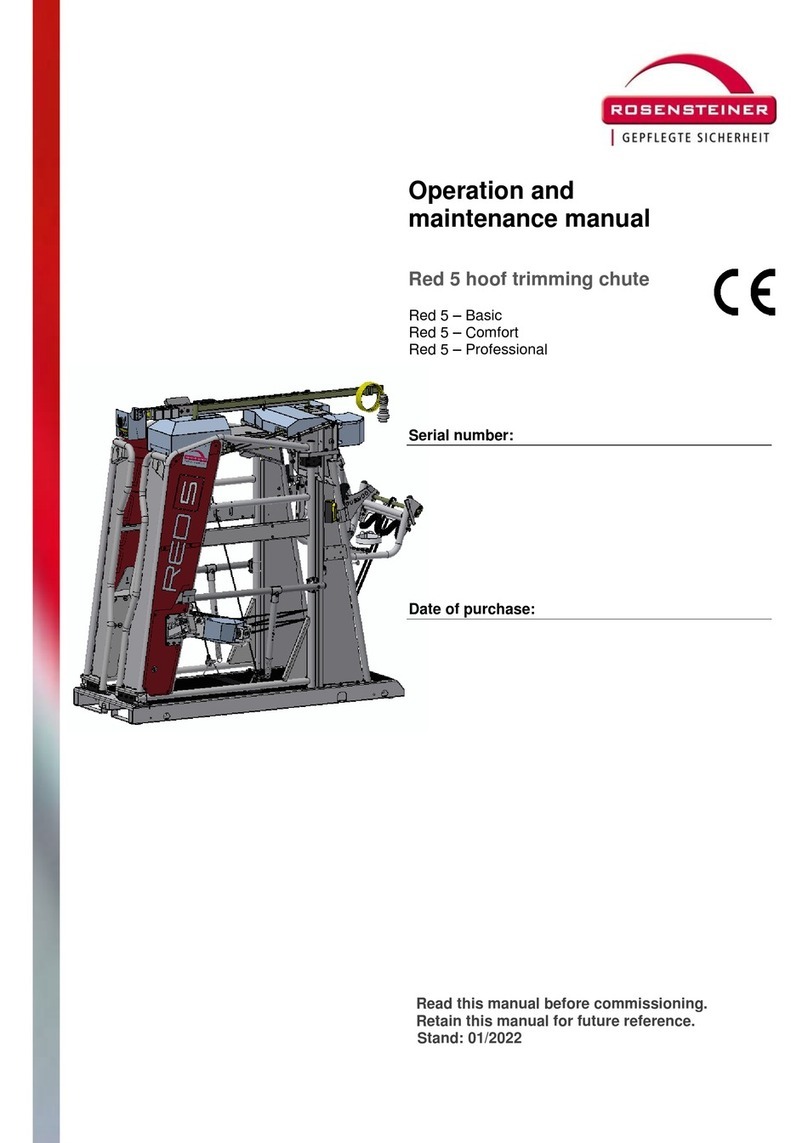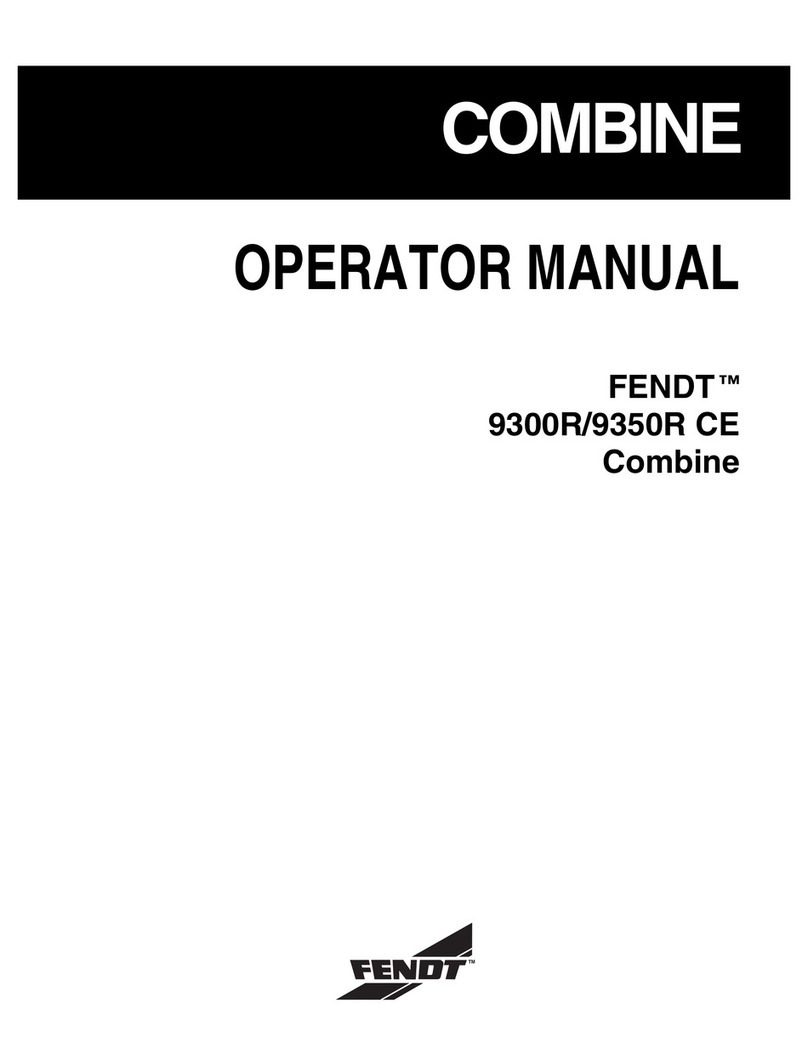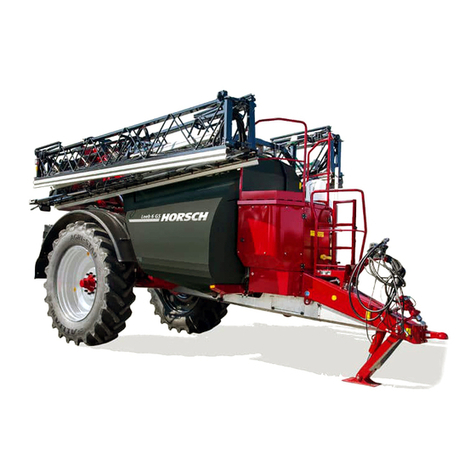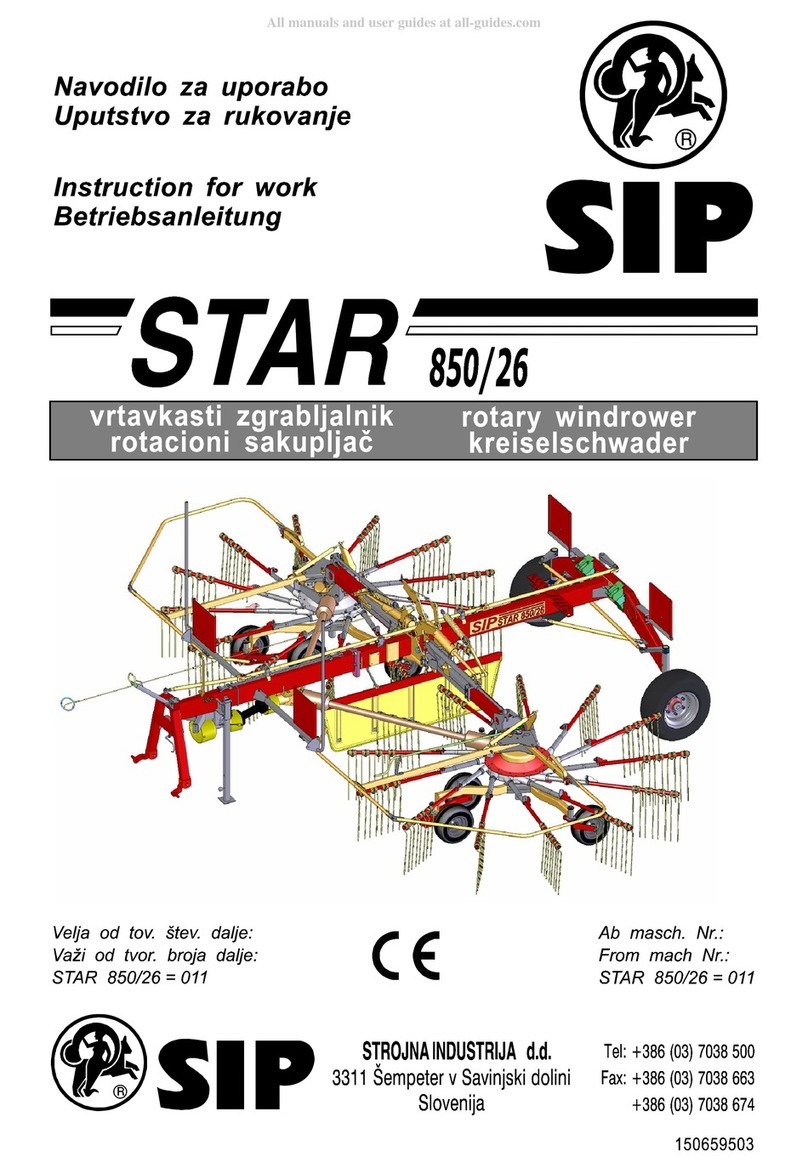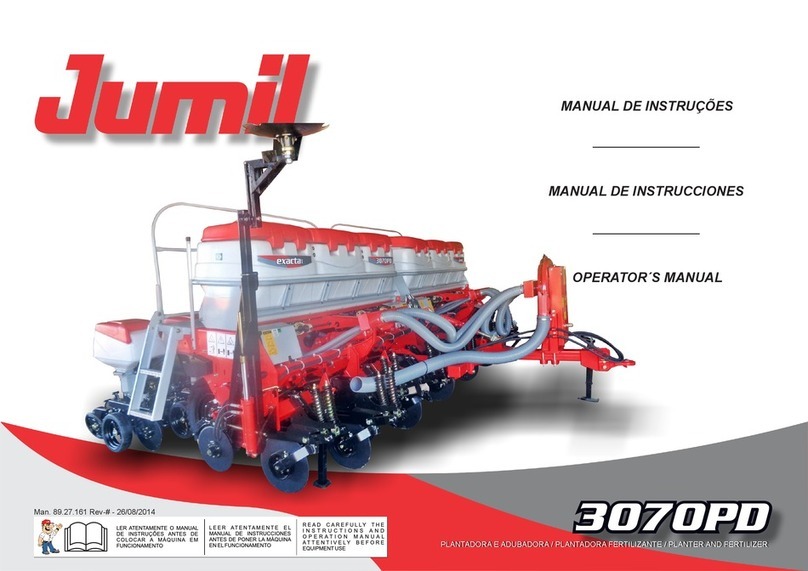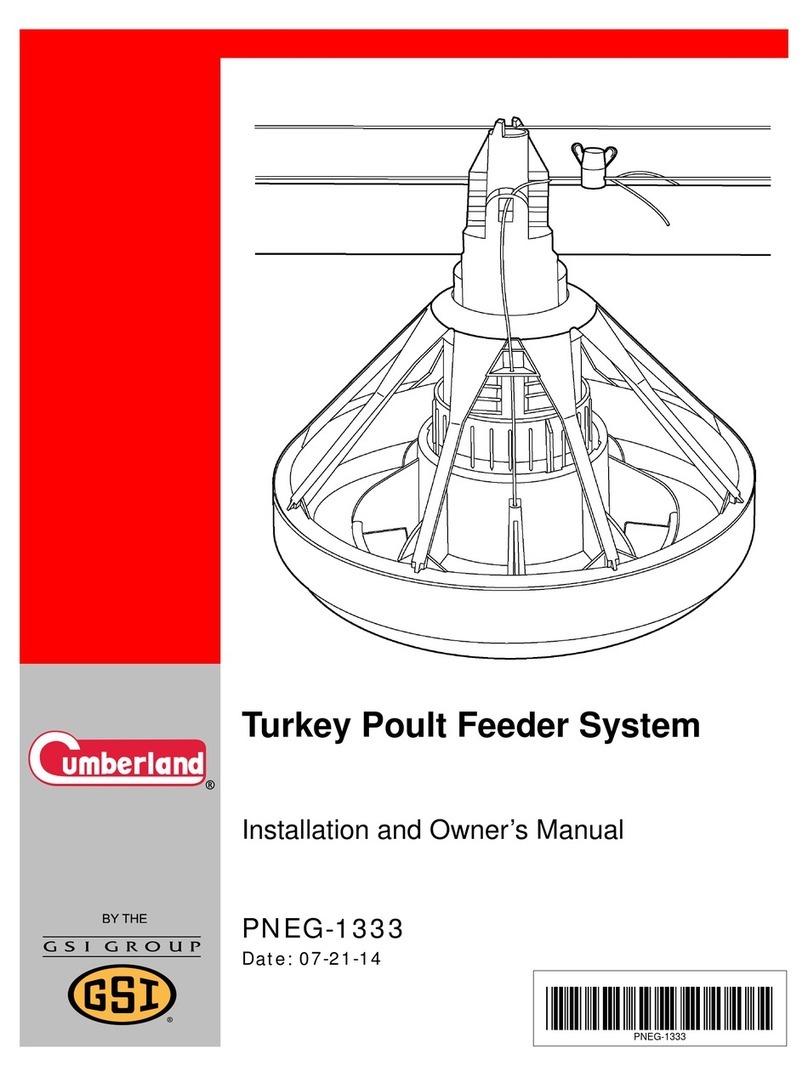Bigham Lilliston Rolling Cultivator Generation 3 User manual

Lilliston® Rolling Cultivator®
Generation 3
Operators Manual
800-692-4449 705 East Slaton Rd. P.O. Box 3338 Lubbock, TX 79452
®
®
®

Page 2
Form # B15-790
®
®
®
Table of Contents
1...............................Cover Page
2...............................Table of Contents
3...............................Safety First
4...............................Warranty
5...............................Safety Requirements
6...............................General Safety Guidelines
7...............................Serial Tag / Manual Holder Tube
8 - 9 .........................Safety Decal Location
10...............................Safety Decal Care / Tire Safety
11...............................Lighting and Marking / Before Operation
12...............................During Operation
13...............................Highway and Transport Operations
14...............................Following Operation / Performing Maintenance
15...............................Performing Maintenance / Hydraulic Fluid and Equipment Safety
16...............................Hydraulic Fluid and Equipment Safety / Lockout/Tagout
17...............................Lockout / Tagout
18...............................Maintenance Chart
19...............................Trouble Shooting
20...............................Use and Care Tips From the Factory / Assistance
21...............................Lilliston Rolling Cultivator Generation 3 Introduction
22...............................Cultivator Overview
23 - 26 .......................Field Use and Adjustment
27 - 48 .......................Part Breakdowns
49 - 51 .......................Notes

Page 3
Form # B15-790
®
®
®
© 2015 Bigham Ag. This document may not be reproduced in whole or in part without prior written permission of Bigham Ag.
P/N B15-790 Revised 11-10-2015. Printed in the U.S.A. Specications and design subject to change without notice.
Do Not Use or Operate This
Equipment Until You Have Read and
Understand This Manual
The purpose of this manual is to explain maintenance requirements and adjustments which
are necessary for the most efcient operation of the machine. Read this manual thoroughly and
completely before using your machine. Keep this manual handy for reference when questions
arise.
Should you have questions or difculties which your dealer or representative are unable to
answer, please call or write:
Bigham Ag
705 E. Slaton Rd.
P.O. Box 3338
Lubbock, TX 79452
Ofce: (800) 692-4449
Fax: (806) 745-1082
SAFETY FIRST
PREVENT ACCIDENTS BY “THINKING SAFETY” IN
UNLOADING, SETTING UP, MOVING, STORAGE AND
OPERATING ALL EQUIPMENT

Page 4
Form # B15-790
®
®
®
A MESSAGE TO THE OWNER AND OPERATOR
This machine was carefully designed and manufactured to give you dependable service. To keep it
running efciently, read the instructions in this Operator’s Manual. Check each item and acquaint yourself
with the adjustments required to obtain efcient operation and maximum performance. Remember, the
machines performance depends on how you operate and care for it.
After each operating season, thoroughly clean your machine and inspect it. Preventive maintenance
saves time and pays dividends. Your dealer has original equipment parts which assure proper t and best
performance. Record the model number, serial number and date of purchase in the space provided on this
page. Your dealer needs this information to give you efcient service when you order parts or attachments. The
model number and serial number appear on the identication plate on the rear left side of the tool bar mast.
The warranty on your machine is included with this manual. Your dealer will review the manual and
warranty with you when you take delivery of your machine.
WARRANTY
Bigham Ag warrants all products of its manufacture to be free from defects in materials and
workmanship for a period of one year from date of delivery to the retail purchaser. Parts assumed to be
defective must be returned F.O.B. Lubbock, Texas for our inspection or inspected in the eld by our
authorized representative. Our obligation under this warranty is limited to replacement or repair of the
defective part and does not cover other damages to persons or property. Other than the aforesaid, no
warranties of merchantability or tness for a particular purpose will apply. We do not assume liability for
altered or remanufactured components or machines or applications beyond their intended use. Some states
do not allow limitation of how long an implied warranty lasts, or exclusions of, or limitations on relief such
as incidental or consequential damages, so the above limitations or exclusion may not apply to you. This
warranty gives you specic legal rights and you may have other rights which vary from state to state.
Warranty does not cover damage due to abuse, neglect, collision, towing, pulling, normal wear and
tear or any other factor beyond the control of the manufacturer. Tool bars that are bent, bowed or that have
been welded on or modied in any way are specically excluded from any warranties.
Model Number:
Serial Number:
Date Of Purchase:
LIMITED LIFETIME WARRANTY ON TOOL BAR CLAMPS
Bigham Ag will replace any ductile iron clamp body that breaks or cracks under normal use for as
long as the original purchaser owns them. This includes all replaceable bolt ductile iron clamps sold by Big-
ham Ag after December 31, 1987.
Clamps that fail should be returned to Bigham Ag, freight prepaid along with caps, bolts, set screws
and nuts for evaluation. If found to have failed under normal operating conditions, a new clamp body will be
returned along with your old caps, bolts, set screws and nuts. Only clamps that have been used with Grade 2
bolts of the proper size will be replaced. All other provisions of the above warranty apply.

Page 5
Form # B15-790
®
®
®
Safety Requirements
TAKE NOTE! THIS SAFETY ALERTS SYMBOL FOUND THROUGHOUT THIS MANUAL IS USED
TO CALL YOUR ATTENTION TO INSTRUCTIONS INVOLVING YOUR PERSONAL SAFETY AND
THE SAFETY OF OTHERS. FAILURE TO FOLLOW THESE INSTRUCTIONS CAN RESULT IN
INJURY OR DEATH.
THIS SYMBOL MEANS
• ATTENTION!
• BECOME ALERT!
• YOUR SAFETY IS INVOLVED!
Signal Words
Note the use of the signal words DANGER, WARNING and CAUTION with the safety messages. The
appropriate signal word for each has been selected using the following guidelines:
DANGER: Indicates an imminently hazardous situation that, if not avoided, will result in death or serious
injury. This signal word is to be limited to the most extreme situations typically for machine components
which, for functional purposes, cannot be guarded.
WARNING: Indicates a potentially hazardous situation that, if not avoided, could result in death or serious
injury, an includes hazards that are exposed when guards are removed. It may also be used to alert against
unsafe practices.
CAUTION: Indicates a potentially hazardous situation that, if not avoided, may result in minor or moderate
injury. It may also be used to alert against unsafe practices.

Page 6
Form # B15-790
®
®
®
General Safety Guidelines
Safety of the operator and any bystanders is one of the main concerns in designing and developing a
new piece of equipment. Designers and manufacturers build in as many safety features as possible. However,
every year many accidents occur which could have been avoided by a few seconds of thought and a more
careful approach to handling equipment. You, the operator, can avoid many accidents by observing the
following precautions in this section. To avoid personal injury, study the following precautions and insist
those working with you, or for you, follow them.
• Replace any CAUTION, WARNING, DANGER or instruction safety decal that is not readable or is
missing. Location of such decals is indicated in this booklet.
• Do not attempt to operate this equipment under the inuence of drugs or alcohol. Do not use the
equipment if alertness or coordination is impaired.
• Review the safety instructions with all users annually.
• This equipment is dangerous to children and persons unfamiliar with its operation. The operators
should be a responsible adult familiar with farm machinery and trained in this equipment’s
operations. Do not allow persons to operate or assemble this unit until they have read this
manual and have developed a thorough understanding of the safety precautions and of how it
works.
• Do not read, eat, drink, talk or text or use a mobile phone while using this equipment.
• To prevent injury or death, use a tractor equipped with a Roll Over Protective System (ROPS). Do not
paint over, remove or deface any safety signs or warning decals on your equipment. Observe all
safety signs and practice the instructions on them.
• Never exceed the limits of a piece of machinery. If its ability to do a job, or to do so safely, is
in question.
- DO NOT TRY IT.
• Stay clear of any moving parts, such as shafts, couplings and universal joints.
• If adjustments need to be made, make them in small steps, shutting down all motions for each adjustment.
• Do not allow anyone to ride on any part of the equipment for any reason.
• Assure that all bystanders are at a safe distance before operating or maintaining this equipment.

Page 7
Form # B15-790
®
®
®
Bigham Ag Serial Tag
The Bigham Ag serial tag provides important information for service and warranty work. The
model number and serial number provide Bigham Ag Dealers and the Bigham Ag Customer Service
department with exact specications of your implement.
• Serial tags are located on the rear left side of toolbars that incorporate a top mast. On toolbars that
do not use a top mast the serial tag is located on the front left of the toolbar.
Bigham Ag Manual Holder
Manual holders contain all relevant owners manuals for the product they are attached to.
Please keep the manual in the tube so that it is easily available to reference back to.
• For toolbars with a top mast manual tubes are located on the front left of the toolbar mast. For
toolbars without a top mast manual tube holders a located on the top left side of the toolbar.

Page 8
Form # B15-790
®
®
®
Safety Decal Locations
• Safety decals are located around to toolbar to warn you of potentially dangerous situations.
• Please pay close attentions to all safety decals.
• Please replace any safety decals that are missing or have become illegible.
FRONT
®
®

Page 9
Form # B15-790
®
®
®
®
®
FRONT
REAR

Page 10
Form # B15-790
®
®
®
Safety Decal Care
• Keep safety signs clean and legible at all times.
• Replace safety signs that are missing or have become illegible.
• Replaced parts that displayed a safety sign should also display the current safety sign.
• Safety signs are available from your Distributor or Dealer Parts Department or the factory.
How to Install Safety Signs:
• Be sure that the installation area is clean and dry.
• Decide on the exact position before you remove the backing paper.
• Remove the smallest portion of the split backing paper.
• Align the decal over the specied area and carefully press the small portion with the exposed
sticky backing in place.
• Slowly peel back the remaining paper and carefully smooth the remaining portion of the decal in
place.
• Small air pockets can be pierced with a pin and smoothed out using the piece of decal backing paper.
Tire Safety
• Failure to follow proper procedures when mounting a tire on a wheel or rim can produce an
explosion which may result in serious injury or death.
• Do not attempt to mount a tire unless you have the proper equipment and experience to do the job.
• Inating or servicing tires can be dangerous. Whenever possible, trained personnel should be
called to service and/or mount tires.
• Always order and install tires and wheels with appropriate capacity to meet or exceed the
anticipated weight to be placed on the equipment.

Page 11
Form # B15-790
®
®
®
Lighting and Marking
• It is the responsibility of the customer to know the lighting and marking requirements of the
local highway authorities and to install and maintain the equipment to provide compliance
with the regulations. Add extra lights when transporting at night or during periods of
limited visibility.
• Lighting kits are available from your dealer or from the manufacturer.
Before Operation
• Carefully study and understand this manual.
• Do not wear loose-tting clothing which may catch in moving parts.
• Always wear protective clothing and substantial shoes.
• Keep wheel lug nuts or bolts tightened to specied torque.
• Assure that agricultural implement tires are inated evenly.
• Give the unit a visual inspection for any loose bolts, worn parts or cracked welds, and make
necessary repairs. Follow the maintenance safety instructions included in this manual.
• Be sure that there are no tools lying on or in the equipment.
• Do not use the unit until you are sure that the area is clear, especially children and animals.
• Don’t hurry the learning process or take the unit for granted. Ease into it and become familiar with
your new equipment.
• Practice operation of your equipment and its attachments. Completely familiarize yourself and
other operators with its operation before using.
• Use a tractor equipped with a Roll Over Protective System (ROPS) and fasten your seat belt prior
to starting the engine.
• The manufacturer does not recommend usage of tractor with ROPS removed.
• Securely attach to towing unit. Use a high strength, appropriately-sized hitch pins with a
mechanical retainer.
• Do not allow anyone to stand between the tongue or hitch and the towing vehicle when backing up
to the equipment.

Page 12
Form # B15-790
®
®
®
During Operation
• Children should never be allowed on the equipment.
• Clear the area of small children and bystanders before moving the equipment.
• Securely attach equipment to towing unit, using correct hitch pin , a metal retainer, and safety
chains if required. Shift towing unit to a lower gear before going down steep
downgrades, thus using the engine as a retarding force. Keep towing vehicle in gear at
all times. Slow down for corners and rough terrain.
• Make sure you are in compliance with all local and state regulations regarding transporting
equipment on public roads and highways. Lights and slow moving signs must be clean and
visible by overtaking or oncoming trafc when cultivator is transported.
• Install the safety chain by crossing the chains under the tongue and secure to the draw bar
cage or hitch or bumper frame.
• Beware of bystanders, particularly children! Always look around to make sure that it is safe to
start the engine of the towing vehicle or move the unit. This is particularly important with
higher noise levels and quiet cabs, as you may not hear people shouting.
• NO PASSENGERS ALLOWED - Do not carry passengers anywhere on, or in, the tractor or
equipment, except as required for operation.
• Keep hands and clothing clear of moving parts.
• Always keep all shields and guards in place and securely fastened.
• Do not clean, lubricate or adjust your equipment while it is moving.
• When halting operation, even periodically, set the tractor or towing vehicle brakes, shut off the
engine and remove the ignition key.
• Be especially observant of the operating area and terrain - watch for holes, rocks or other hidden
hazards. Always inspect the area prior to operation.
— DO NOT operate near the edge of drop-offs or banks.
— DO NOT operate on steep slopes as overturn may result.
— Operate up and down (not across) intermediate slopes. Avoid sudden starts and stops.
• Adopt safe driving practices:
— Keep the brake pedals latched together at all times. NEVER USE INDEPENDENT
BRAKING

Page 13
Form # B15-790
®
®
®
Highway and Transport Operations
WITH MACHINE IN TOW A LOSS OF CONTROL AND/OR UPSET OF UNIT CAN RESULT.
— Always drive at a safe speed relative to local conditions and ensure that your speed is
low enough for an emergency stop to be safe and secure. Keep speed to a minimum.
— Reduce speed prior to turns to avoid the risk of overturning.
— Avoid sudden uphill turns on steep slopes.
— Always keep the tractor or towing vehicle in gear to provide engine braking when going
downhill. Do not coast.
— Do not drink and drive!
• Comply with state and local laws governing highway safety and movement of farm machinery
on public roads.
• Use approved accessory lighting ags and necessary warning devices to protect operators of
other vehicles on the highway during daylight and nighttime transport. Various safety lights and
devices are available from your dealer.
• The use of ashing amber lights is acceptable in most localities. However, some localities prohibit
their use. Local laws should be checked for all highway lighting and marking requirements.
• When driving the tractor and equipment on the road or highway under 20 mph at night or during
the day, use ashing amber warning lights and a slow moving vehicle (SMV) identication emblem.
• Plan your route to avoid heavy trafc.
• Be a safe and courteous driver. Always yield to oncoming trafc in all situations, including
narrow bridges, intersections, etc.
• Be observant of bridge loading ratings. Do not cross bridges rated lower than the gross weight
as which you are operating.
• Watch for obstructions overhead and to the side while transporting.
• Always operate equipment in a position to provide maximum visibility at all times. Make
allowances for increased length and weight of the equipment when making turns, stopping
the unit, etc.
• Pick the levelest possible route when transporting across elds. Avoid the edges of ditches or
gullies and steep hillsides.
• Be extra careful when working on inclines.
• Maneuver the tractor or towing vehicle at safe speeds.

Page 14
Form # B15-790
®
®
®
• Avoid overhead wires or other obstacles. Contact with overhead lines could cause serious injury
or death.
• Avoid loose ll, rocks and holes; they can be dangerous for equipment operation or movement.
• Allow for unit length when making turns.
• Operate the towing vehicle from the operator’s seat only.
• Never stand alongside of unit with engine running or attempt to start engine and/or operate
machine while standing alongside of unit.
• Never leave running equipment attachments unattended.
• As a precaution, always recheck the hardware on equipment following every 100 hours of
operation. Correct all problems. Follow the maintenance safety procedures.
Following Operation
• Following operation, or when unhitching, stop the tractor or towing vehicle, set the brakes,
shut off the engine and remove the ignition keys.
• Store the unit in an area away from human activity.
• Do not permit children to play on or around the stored unit.
• Make sure all parked machines are on a hard, level surface and engage all safety devices.
• Wheel chocks may be needed to prevent unit from rolling.
Performing Maintenance
• Good maintenance is your responsibility. Poor maintenance is an invitation to trouble. Proper
servicing and adjustments are key to the long life of any implement. With careful
inspection and routine maintenance, costly downtime and repairs can be avoided.
• Some parts and assemblies can be quite heavy. Before attempting to unfasten any part or
assembly, arrange to support it by means of a hoist, by blocking or by use of an adequate
arrangement to keep it from falling, tipping, swinging or moving in any manner which may
hurt somebody or damage the equipment.
• Always use lifting equipment that is adequately rated to do the job. Never lift equipment over people.
• Make sure there is plenty of ventilation. Never operate the engine of the towing vehicle in a
closed building. The exhaust fumes may cause asphyxiation.
• Before working on the equipment, stop the towing vehicle, set the brakes, disengage all power
drives, shut off the engine and remove the ignition keys.

Page 15
Form # B15-790
®
®
®
• Be certain all moving parts on attachments have come to a complete stop before attempting to
perform maintenance.
• Always use a safety support and block the wheels. Never use a jack to support the equipment.
• Always use the proper tools or equipment for the job at hand.
• Use extreme caution when making adjustments.
• Never replace hex bolts with less than grade ve bolts unless otherwise specied.
• After servicing, be sure all tools, parts and service equipment are removed.
• Where replacement parts are necessary for periodic maintenance and servicing, genuine factory
replacement parts must be used to restore your equipment to original specications. The
manufacturer will not claim responsibility for use of unapproved parts and/or accessories
and other damages as a result of their use.
• If equipment has been altered in any way from original design, the manufacturer does not accept
any liability for injury or warranty.
• If repairs require the use of a torch or electric welder, be sure that all ammable and combustible
materials are removed.
• Do not weld or cut on any tank containing oil, fuel or their fumes or other ammable material, or
any container whose previous contents are unknown.
• Cleaning solvents should be used with care. Petroleum based solvents are ammable and present
a re hazard. Don’t use gasoline. All solvents must be used with adequate ventilation and
their vapors should not be inhaled.
Hydraulic Fluid and Equipment Safety
Only adequately trained and qualied persons should work on hydraulics systems. You may be
severely injured or killed by being crushed under a falling piece of equipment. Always have transport locks
in place and frame sufciently blocked when working on any implement.
Hydraulic uid escaping under pressure can have sufcient force to cause injury. Keep all hoses and
connections in good serviceable condition. Failure to heed may result in serious personal injury or death.
Escaping hydraulic uid under pressure can have sufcient pressure to penetrate the skin causing serious
injury. Avoid the hazard by relieving the pressure before disconnecting lines or performing work on the
system.
Make sure hydraulic uid connections are tight and all hydraulic hoses and lines are in good condition
before applying pressure to the system. Use a piece of paper or cardboard, NOT BODY PARTS, to check

Page 16
Form # B15-790
®
®
®
for suspected leaks. Wear protective gloves and safety glasses or goggles when working with hydraulic
systems. DO NOT DELAY! If an accident occurs, see a doctor familiar with this type of injury immediately.
Any uid injected into the skin or eyes must be treated within a few hours or gangrene may result.
Always secure equipment with solid supports before working on or under it. Never work under
equipment supported by hydraulics. Hydraulics can drop equipment if controls are actuated or hydraulic lines
burst or pressure is lost while disconnecting lines. Either situation can drop machinery instantly even when
power to hydraulics is off. Do not attempt to disconnect a hydraulic cylinder or hose while the system is
under pressure! Check hydraulic hoses and ttings frequently. Brush and other debris can damage hoses and
ttings. Inspect and maintain equipment daily. Loose, broken, and missing hardware can cause equipment
to not perform properly and can result in bodily injury or death.
Hydraulic systems and oil can be hot and cause burns. Before working on any system, wait until the
oil has cooled.
Lockout / Tagout
Think, plan and check. Think through the entire procedure and identify all the steps that are required.
Plan what personnel will be involved, what needs to be shut down, what guards need to be removed, and how
(and under what conditions) the power will be restarted. Check the machine over to verify all power sources
and stored energy have been identied including engines, hydraulic and pneumatic systems, springs and
accumulators, and suspended loads, Shutoff and lockout power before adjusting, servicing, maintaining, or
clearing an obstruction from this machine. Failure to heed may result in serious injury or death. Communicate
with everyone involved in a repair or maintenance operation, including bystanders, that work is being done
which involves keeping this machine safety at a ZERO ENERGY STATE.
OSHA’s requirements for lockout/tagout are covered in Section 1910.147 of the OSHA standards.
The LOTO standard establishes the employer’s responsibility to protect workers from hazardous energy.
Employers are required to train each worker to ensure that they know, understand, and are able to follow the
applicable provisions of the hazardous energy control procedures:
• Proper lockout/tagout (LOTO) practices and procedures safeguard workers from the release of
hazardous energy. The OSHA standard for The Control of Hazardous Energy (Lockout/Tagout)
for general industry, outlines specic action and procedures for addressing and controlling
hazardous energy during servicing and maintenance of machines and equipment. Employers
are also required to train each worker to ensure that they know, understand, and
are able to follow the applicable provisions of the hazardous energy control procedures.
Workers must be trained in the purpose and function of the energy control program and have
the knowledge and skills required for the safe application, usage and removal of the energy
control devices.
•

Page 17
Form # B15-790
®
®
®
• All employees who work in the area where the energy control procedure(s) are utilized need to
be instructed in the purpose and use of the energy control procedure(s) and about the prohibition
against attempting to restart or reenergize machines or equipment that is locked or tagged out.
• All employees who are authorized to lockout machines or equipment and perform the service
and maintenance operations need to be trained in recognition of applicable hazardous energy
sources in the workplace, the type and magnitude of energy found in the workplace, and the means
and methods of isolating and/or controlling the energy.
• Specic procedures and limitations relating to tagout systems where they are allowed.
• Retraining of all employees to maintain prociency or introduce new or changed control methods.
OSHA outlines a six-step procedure for controlling hazardous energy:
• Step 1: Prepare for shutdown. It must be determined what type of power system is going to be
deactivated including electrical, hydraulic, pneumatic or other energy sources. Knowledge of
shut down methods is necessary.
• Step 2: Shutdown the equipment. This should be completed consistent with the
manufacturer’s instructions for the shutdown procedure and could be a simple as placing a
switch in the “off” position or pressing a button.
• Step 3: Isolate the equipment. This step involves closing of valves, throwing the main
disconnects or circuit breakers and disconnecting or capping any auxiliary power sources or
secondary electrical systems.
• Step 4: Apply the lockout/tagout device. This is done to prevent restoration of the ow of
energy and is done at all disconnect switches, valves or other energy isolating devices. Locks
are the preferred method of controlling energy and should be supplemented with tags.
Various lockout devices are available including group lockout hasps. Locks should be individually
assigned and have only one key.
• Step 5: Control the stored energy. This step includes the release, disconnect or restraint of any
residual hazardous energy which may be present and a check that all moving parts have stopped
moving. It may also include the installation of “pancakes” or blanking of pipe anges, the
installation of ground wires to discharge electrical capacitors and the blocking or supporting
of elevated equipment.
• Step 6: Verify isolation of equipment. Double-check the steps and verify that the equipment
indeed has been shut down and that the lock and tag do control the stored energy. Employees
should be warned and the system tested, including pressing of all start buttons to assure that
the equipment will not start.

Page 18
Form # B15-790
®
®
®
Maintenance Chart
Lubrication
• Lubricate the grease tting in the hinge pivots of the folding toolbars with a multi purpose grease every
50 hours of operation.
Fasteners
• All fasteners should be checked and re-tightened after the initial thirty minutes of operation.
• All fasteners should be checked and re-tightned after every 25 hours of operation.
Seasonal Maintenance
• Clean the cultivator thoroughly to remove dirt and trash which could hold moisture and cause rusting.
• Apply a good rust preventative to all land polished surfaces, such as spiders and sweeps.
• Lubricate all toolbar grease ttings to ll cavities and prevent moisture build up.

Page 19
Form # B15-790
®
®
®
Troubleshooting
Problem Cause Correction
Insufcient penetration of rear
gangs while cultivating or
mulching beds.
Gangs angled in the wrong direc-
tion.
Reverse angle. Gang number 1
cuts and moves soil to the left.
Gang number 2 cuts and moves
soil to the right.
Not enough angle. Increase angle of gangs. Tilt gang
an additional 10 degrees on tilt
adjustment plate.
Incorrect toolbar angle. Lengthen top link linkage to
roll the toolbar backward until
the front and rear spider gangs
engage the soil evenly.
Not enough pressure on gangs. Decrease implement height on
three point lift.
Excessive penetration of rear
gangs while cultivating or
mulching beds.
Incorrect toolbar angle. Shorten top link linkage to roll
the toobar forward until the front
and rear spider gangs engage to
soil evenly.
Gangs clogging between fork and
spider.
Soil contains rocks, hard clods,
crop residue.
Add scraper between fork and
spider.
Covering small crop when
cultivating.
Too much angle on the spider
gangs.
Decrease spider gang angle unit
until the crop is bigger.
Insufcient dirt movement
towards the row crop.
Not enough angle on the spider
gangs.
Increase spider gang angle until a
sufcient amount of dirt is mov-
ing towards the row crop.
Side draft on tractor. (Cultivator
does not trail behind tractor)
Row units not in the center of the
furrow.
Check row spacing at the point of
the sweep. Adjust units on bar as
necessary.
Toolbar not level Adjust three point lift arm link-
ages to level the toolbar.
Unequal penetration of rear
gangs.
Decrease implement height on
three point lift.
Row gangs wearing unevenly. Soil compaction behind tractor. Rotate rear gangs that operate
behind tractor tires.
Row gangs wearing rapidly or
unevenly.
Cultivator toolbar not positioned
properly.
Adjust top link until the front
and rear spider gangs are evenly
engaging the ground.
Row gangs are being run too
deep.
Increase the set height of the
three point lift.

Page 20
Form # B15-790
®
®
®
Troubleshooting Continued
Problem Cause Correction
Toolbar bending. Loading beyond design limit with
deep tillage tools such as bed rip-
pers, irrigation shovels, etc.
Attach cable pull ears from each
end of the toolbar to the front of
the tractor.
Bending and twisting of coulter
assembly.
Turning with the coulter in the
ground with rigid tractor hitch.
Make sure coulter clears ground
before turning at the end of the
row.
Coulter bearing failure. Running coulter too deep. Adjust coulter setting. Never run
coulter hub or bearing in the dirt.
Use and Care Tips From the Factory
• Spending the time to properly set your cultivator in the beginning will pay dividends in the end.
• When rebuilding spider gangs make sure the spiders are timed properly. Number 1 spiders are
equipped with a single timing mark and number 2 spiders are equipped with a double timing mark. Timing
marks are to be set 90 degrees out from any adjacent spiders.
Assistance
• If you have questions not answered in this manual or require additional copies, please contact your dealer
or Bigham Ag.
705 East Slaton Road, Lubbock, Texas, 79452
Ofce: (800) 692-4449 Fax: (806) 745-1082
www.bighamag.com
Table of contents
Other Bigham Farm Equipment manuals
Popular Farm Equipment manuals by other brands

HARVEST
HARVEST A1072 Operator's manual
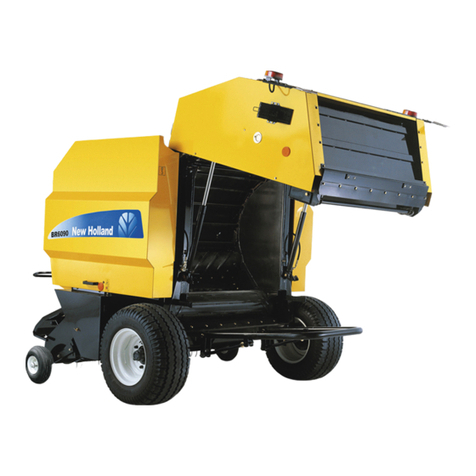
New Holland
New Holland BR6080 Operator's manual
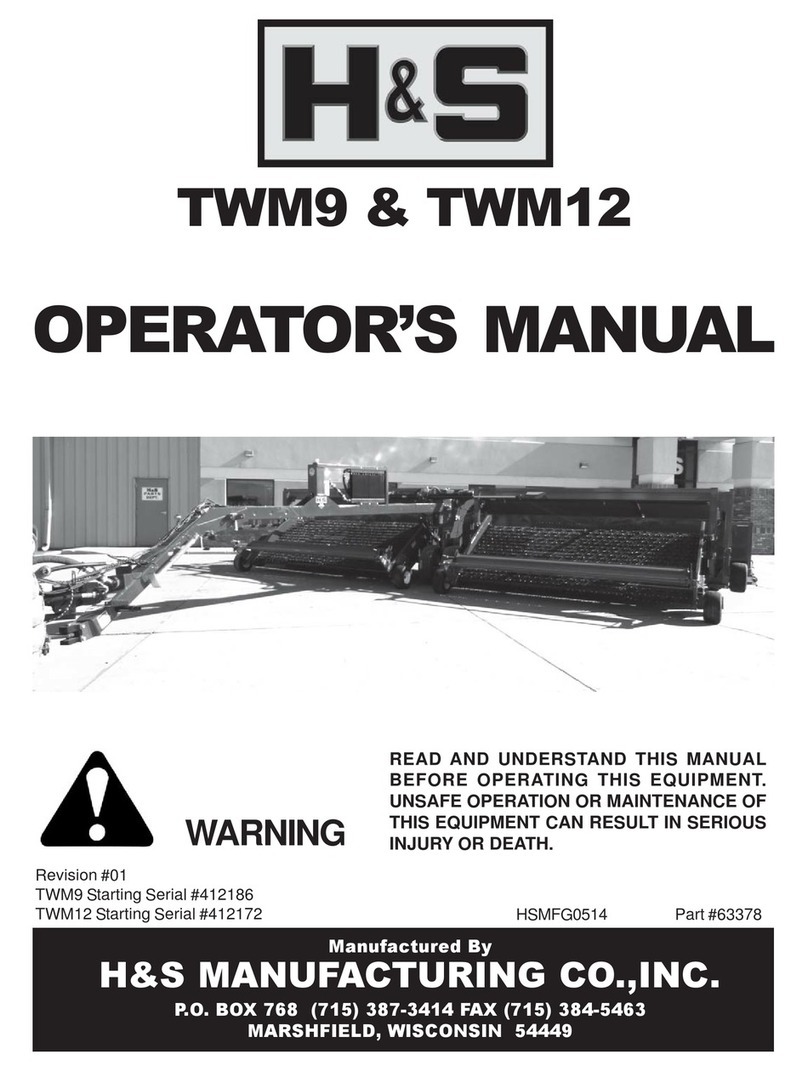
H&S
H&S TWM9 Operator's manual
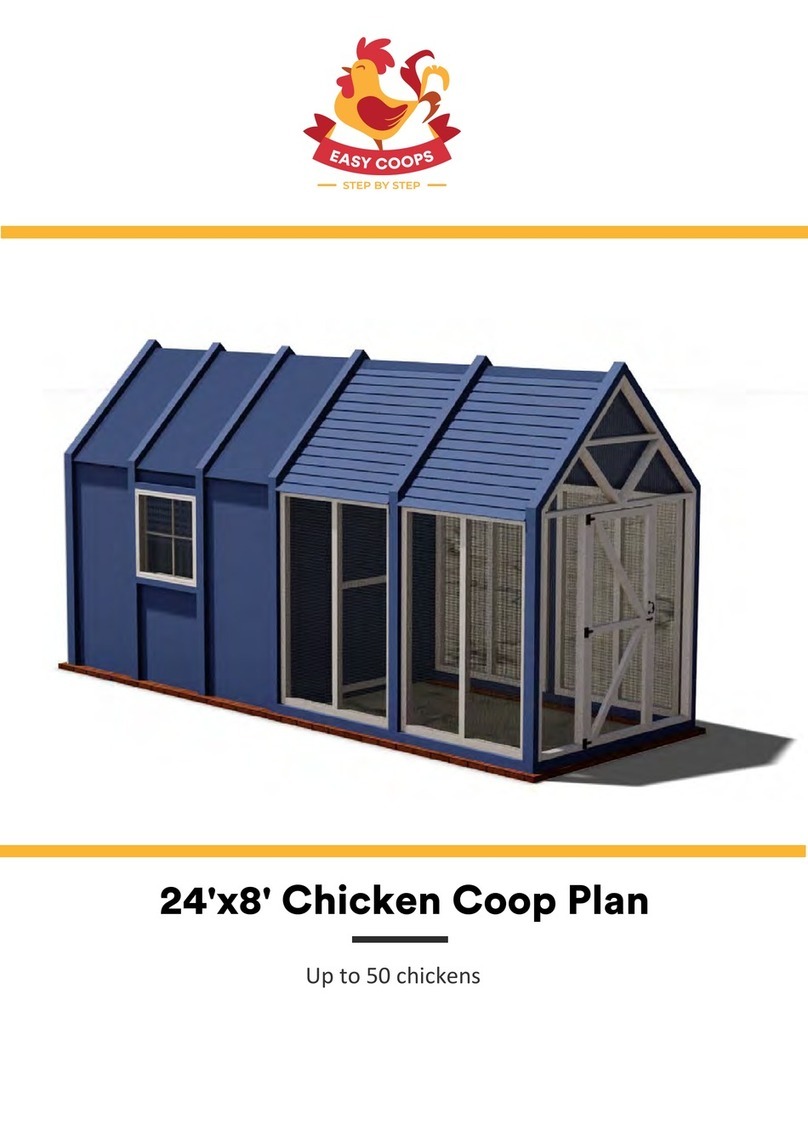
EASY COOPS
EASY COOPS 24x8 Chicken Coop Plan manual
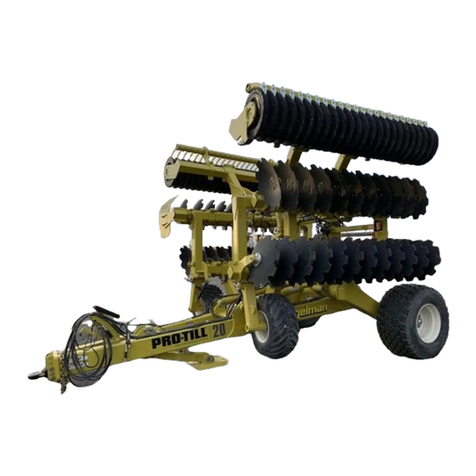
Degelman
Degelman Pro-till 26 quick start guide
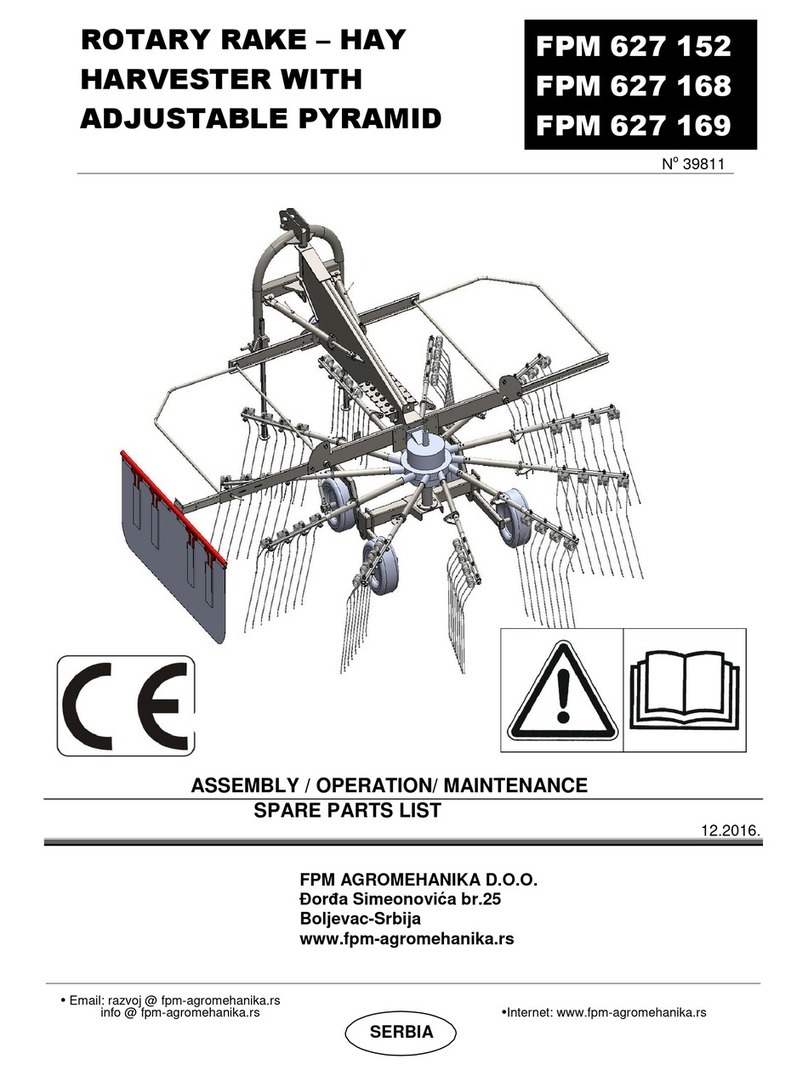
FPM Agromehanika
FPM Agromehanika 627 152 ASSEMBLY / OPERATION/ MAINTENANCE, SPARE PARTS LIST
